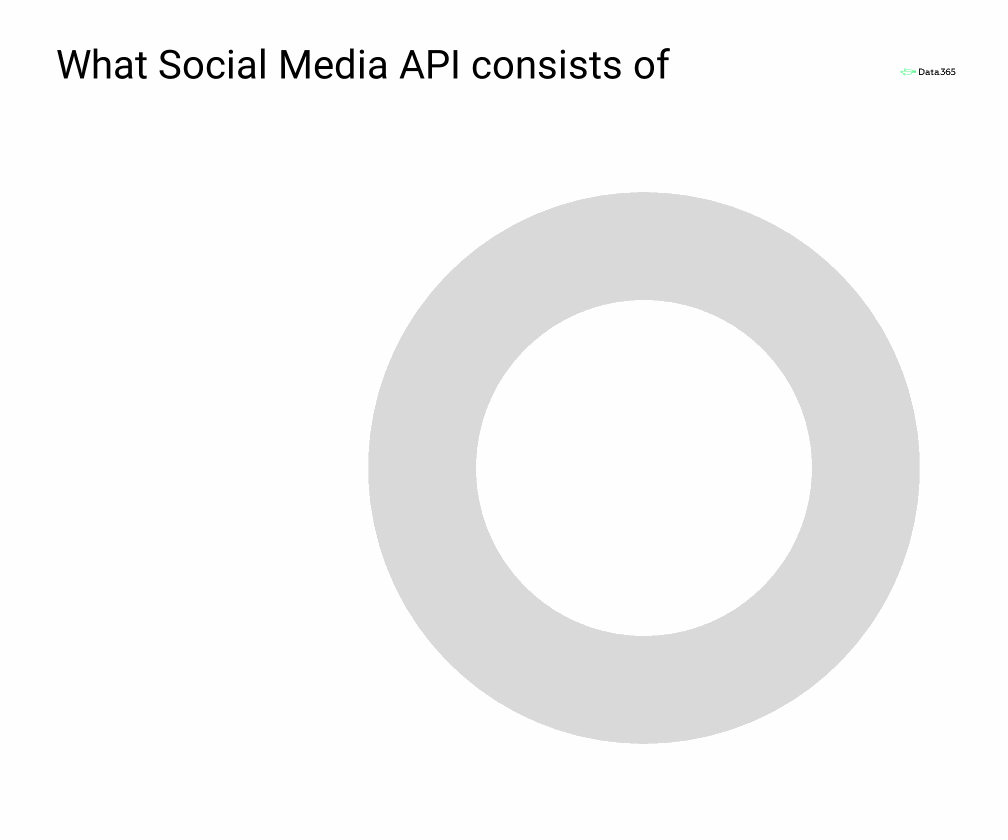
X (formerly Twitter) currently has an audience of almost 600 million monthly active users, making it a rich source of data for AI training, brand monitoring, and sentiment analysis. However, here’s the truth of the matter: Python coders still rack their brains, juggling three options — the official X API, self-built scrapers, and third-party tools.
This manual breaks down each of the three scenarios: scraping, the official API, and third-party APIs, such as the Social Media API by Data365. You will learn about useful libraries in Python, get into the integration intricacies, and discover how to get fresh data without compromising quality or blowing a hole in a budget.
In short: Twitter data = API + Python. That’s the way to success (check it yourself).
Require tweets pulled out yesterday? Start with Data365 today to know what will be trending tomorrow.
Short Overview
- Extracting tweets from Twitter using Python is possible in three main ways: a self-built scraper, an official X API, or a third-party API tool.
- The official Twitter API provides reliability and robustness; however, it is very high in cost, starting with $200 and up to $5,000+/month, making it impossible to afford for startups or small/mid-sized businesses.
- Python offers many open-source libraries to simplify and save up on the tweet retrieval process, but devs often get stuck with broken scrapers due to X’s anti-bot strategies, rate limits, and ever-changing X infrastructure.
- Third parties like Data365 Social Media API often come up as a go-to solution for development teams and growing companies.
- Social Media API by Data365 is fully compatible with Python and any other programming language, including JavaScript, Ruby, C#, etc.
- Data365 has also powered the Social Media API with high scalability, clear documentation, and simple token access, as well as affordable pricing.
Option #1 to Get Data From Twitter: API & Python Combination
When it comes to extracting tweets from Twitter using Python, most programmers get on X’s hook. The official API literally shouts: “Pick me – I am reliable!” Still, it’s only attractive until the invoice arrives. Let's unpack it.
Developers frequently mix the X (Twitter) API v2 with Tweepy, a free, open-source Python library that simplifies the integration. And it really all starts out so nice: install via pip install tweepy, grab your Bearer Token at the developer portal, and begin querying.
But here comes the punchline: at the end of 2025, the API pricing of X appears as shown below:
- Free (0/month): 100 reads, 500 writes — good only in case of simple testing.
- Basic (200/month): 15,000 reads and 50,000 writes — works with prototypes or even small projects, but not with production.
- Pro (5,000/month): 1 million reads, full-archive search, and filtered streams — the large companies will buy, but most developers or startups cannot afford.
Ouch — your sentiment analysis side hustle is now an enterprise-grade investment. So what then? No cry. The dream of getting tweets without a headache, and this is where it can be found.
Why Teams Choose Data365 Social Media API
If you want to get Twitter data — API & Python combo is the best option. Due to the reliability, scalability, and high level of features, teams pick Data365 Social Media API to get public Twitter data in an easy and efficient way. Key benefits include:
- Scalability and reliability: Supports data of any size with 99.9 % availability, which is vital to critical projects. Data365 utilizes best server-side data collection practices without reverse-engineering and browser automation.
- The developer-centric approach: The wide documentation of the products, excellent instructions on how to set up, and a personal support team make the integration and troubleshooting easier.
- Crystal-clear pricing: Transparent per-use pricing that scales accordingly to your needs with a free 14-day trial.

Data365 can also address most of your requests for public tweet data by utilizing these endpoints:
- /twitter/post — get the Tweets information and their metadata.
- /twitter/profile — view user profile information.
- /twitter/post/search — search by keywords and filters.
- twitter/profile/search — search Twitter profiles.
And although Python is a go-to choice (with requests or httpx), the RESTful structure of Data365 makes it work with nearly any language. No matter what stack you use: JavaScript (Node.js), Go, Java, C#, or Ruby, you just have to send an authenticated HTTP request. This language-neutral technique makes it easy to adopt in cross-functional teams and eliminates vendor lock-in.
Ready to try? Book a call — your no-cost trial is up now.
Option #2: Python Code to Get Twitter Data
To most people, creating a custom Python scraper is akin to creating custom solutions. To deal with dynamic pages, automate browser sessions, and work with data, popular guides suggest libraries such as Selenium, Playwright, Pandas, and BeautifulSoup. Although this method provides complete flexibility with the scraping logic and page navigation, it is a technical time sink: the scripts have to keep up with the changes in Twitter layout, anti-bot strategies, and rate limits, i.e., update regularly and fail to work.
Many also consider snscrape as a fast solution. However, there is a twist: it stopped working in 2023 after X had implemented a login wall. But there’s an alternative. Rather than struggling to break through the defenses of Twitter, collaborate with a tool that operates according to its rules. The Data365 Social Media API comes into play there.
Consider it a middle ground between the power of Python and the complexity of Twitter. There is no need to reverse-engineer endpoints or deal with headless browsers. With a short Python code to get Twitter data using requests or httpx and a single token, you can set preferable parameters and start the retrieval process with well-structured endpoints. Data365 does all the hard work, like rate limiting, data formating, etc., leaving your script stable.
This is a direct comparison of the reasons why teams prefer APIs to scrapers for their business processes.
The real cost isn't just infrastructure — it's opportunity cost. Every hour spent maintaining a fragile scraper is an hour not spent building features, training models, or generating insights. So, think of it when choosing.
Why to Use Twitter Data: API, Python and Stories of Success
Twitter is not just a social network, but a real-time beat of conversation around the world. It provides real-time insights into what people think, feel, and share. Using APIs and Python, teams can extract tweets, which represent large volumes of real-time text data, ready to be analyzed or fed through ML technologies.
Common use cases

- Brand monitoring & sentiment analysis — monitor brand mentions, identify crises in early stages, and determine the audience perception of PR campaigns.
- Trend forecasting — discover new trends or viral content before it reaches the mainstream news.
- AI & machine learning — train NLP and predictive models by feeding them with raw and fresh tweet data.
- Political and social research — examine popular conversation, thoughts, and feelings about social or political events.
- Cybersecurity — keep track of suspicious accounts or threat red flags to help in early detection and response.
The Social Media API from Data365 assists businesses and academics in scaling their Twitter data activities with no reliability or compliance issues:
Buzztech
A social listening platform from Italy, has collaborated with Data365 to gather well-structured information in real time in order to power its work processes. This allowed it to reduce data acquisition expenses by 30% and to drive an international social intelligence platform.
A healthcare analytics company
They used the Social Media API to retrieve almost 7,000 posts in real-time to conduct sentiment tracking during COVID-19. As a result, the team was able to enhance the effectiveness of their communication and spread community trust.
Eleve
A Hungarian brand advocacy platform cooperates with our API to conduct intensive social media monitoring and text analytics. The company aims to identify the right target audiences and influencers by studying hundreds to thousands of user profiles for each client.
A cybersecurity agency
The US-based cybersecurity company has conducted a deep investigation campaign aimed at improving the security of the digital landscape. Thanks to Data365, they gathered data, including tweets, and input it into a live threat-monitoring dashboard, increasing the accuracy of detection based on constant data flow.
Data365 balances technical strength and accessibility. So, if you need to get data from Twitter, API & Python combination is the best investment into your project.
Final Insights on Extracting Tweets with Python
The actual worth of the fresh, structured Twitter data is not defined by the number of hours you spend debugging access codes, but rather by the effectiveness and dependability of the selected data access tool. Scrapers make promises of freedom but give instability. The official API provides compliance at an absurd cost.
Social Media API with Data365 fixes both of the options: clean and structured data at a reasonable price, pulled out through uncomplicated HTTP requests. You may be training AI models, analyzing brand sentiment, or even charting global trends, but the process of extracting tweets from Twitter using Python should be stable, not subject to debugging all the time.
Stop maintaining scrapers. Start building insights. Book a call to get your personal 14-day free trial from Data365.
Extract data from five social media networks with Data365 API
Request a free 14-day trial and get 20+ data types








.svg)
.svg)
.svg)






.svg)
.svg)
.svg)
